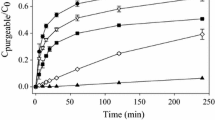Abstract
New experiments have been conducted to determine the speciation of dissolved mercury (Hg) over wide pH (1–12) and sulfide concentration ranges (0.5–30 mM) and in the presence of elemental sulfur (S0) or Hg0, conditions that encompass those of near-bottom and pore waters of sediments. Samples containing synthetic red mercuric sulfide (HgS, cinnabar), buffer solution, aliquots of bisulfide (HS−1) solution, and, in special cases, S0 or Hg0 were prepared anaerobically and allowed to equilibrate for several months. Filtered samples were analyzed for pH, total sulfide (ΣS2−), and total mercury [Hg]tot. Plots of [Hg]tot values vs. pH at varying ΣS2− verified the formation of three previously known mercury-sulfide complexes (HgS2Hn n−2) and revealed that a new Hg2SOH+ complex is important at low pH and low ΣS2−. Our constants for ionic strength (I) 0.7 and 250 C are as follows: K1=10−5.76(+0.71, −1.02) for HgScinn+H2S ↔ HgS2H2 0; K2=10−4.82(+0.72, −1.10) for HgScinn+HS− ↔ HgS2H−; K3=10−13.41(+0.76, −0.93) for HgScinn+HS− ↔ HgS2 2−+H+; K4=10−8.36(+0.71, −0.93) for 2HgScinn+H++H2O ↔ Hg2SOH++H2S. With decreasing pH, below 1, Hg solubility decreased sharply, indicating the formation of a new solid phase, inferred to be corderoite (Hg3S2Cl2). From our solubility data, we calculated the free energy of formation (ΔGf o) of Hg3S2Cl2 to be −396 (+3, −11) kJ/mol. In experiments where excess S0(s) was present, a new mercury-polysulfide dimer was identified; its formation constant is K5=10−1.99(+0.69, −1.27) for 2HgScinn+2HS− + nS0 ↔ Hg3S4 IISn oH2 2−. Data from experiments where Hg0(aq) was added confirmed the reversibility of HgS dissolution. An application of our mercury-sulfide speciation model to a natural anoxic basin, Saanich Inlet, British Columbia, is discussed.
Similar content being viewed by others
References
Foord, E. E. and Berendsen, P.: 1974,Amer. Mineral. 59, 652–655.
Lu, X., Johnson, W. K., Wong, C. S.: 1986,Mar. Pollut. Bull. 17, No. 6, 263–267.
Schwarzenbach, G. and Widmer, M.: 1963,Helv. Chim. Acta. 46, 2613–2628.
Williamson, M. A. and Rimstidt, J. D.: 1992,Geochim. et Cosmochim. Acta. 56, 3867–3880.
Author information
Authors and Affiliations
Rights and permissions
About this article
Cite this article
Paquette, K., Helz, G. Solubility of cinnabar (red HgS) and implications for mercury speciation in sulfidic waters. Water Air Soil Pollut 80, 1053–1056 (1995). https://doi.org/10.1007/BF01189765
Issue Date:
DOI: https://doi.org/10.1007/BF01189765




